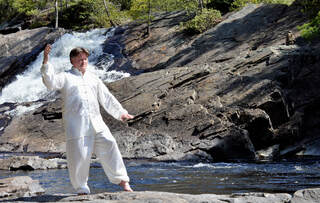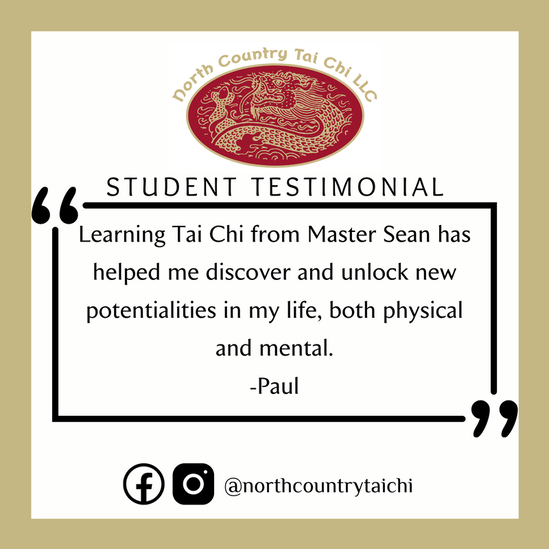Helpful Concepts in Understanding Tai Chi

Focused Relaxation
Tai Chi is a wisdom tradition that teaches how to move in a relaxed but focused state of awareness. We teach that relaxation is the natural state of your being and offer tools for maintaining, or even regaining it. Just think about how you are when you are secure, without fear, and without need. An educated guess is that its awesome to be around you! It may sound funny, but Tai Chi is a martial art best learned and practiced in this state of being and we help you achieve it.
Tai Chi is a wisdom tradition that teaches how to move in a relaxed but focused state of awareness. We teach that relaxation is the natural state of your being and offer tools for maintaining, or even regaining it. Just think about how you are when you are secure, without fear, and without need. An educated guess is that its awesome to be around you! It may sound funny, but Tai Chi is a martial art best learned and practiced in this state of being and we help you achieve it.

Playing of Pairs
The play of opposites is at the heart of any attuned Tai Chi practice. We are active, we are still. We are firm, we are soft. We are empty, we are full. We are _____, we are not______. We remain cognizant of each pair's polarity, as well as, the transition between them.
The play of opposites is at the heart of any attuned Tai Chi practice. We are active, we are still. We are firm, we are soft. We are empty, we are full. We are _____, we are not______. We remain cognizant of each pair's polarity, as well as, the transition between them.

Pulsing of Pairs
We breath in, we breath out. We shift forward, we shift back. We wind up, we wind down. We do all of this slowly, attuning more and more to a relative smoothness, a sort of oscillating resonance expressed by flexibility and an increasingly graceful control of movements. By paying attention to pulse, we can give an "off" the same attention as our "on", something busy people rarely get the time to do.
We breath in, we breath out. We shift forward, we shift back. We wind up, we wind down. We do all of this slowly, attuning more and more to a relative smoothness, a sort of oscillating resonance expressed by flexibility and an increasingly graceful control of movements. By paying attention to pulse, we can give an "off" the same attention as our "on", something busy people rarely get the time to do.

Playing with Multiple Pairs
Above, we mentioned the pairs of (empty vs. full) and (active vs. still). Let's try an exercise that plays with elements of two pairs.
First, stand on two feet shoulder width apart. Shift your weight from evenly weighted to mostly weighted to the right. Now, move back to even. Then, shift weight mostly to the left. After playing with the shift, go ahead and bring your feet closer together, let's say there should be six inches separating the feet. Now, shift your weight mostly to the right. Then pick up your left foot like you are going to step forward onto ice that you aren't sure will hold your weight. Pause.
The raised left foot is (empty & active) the right foot is now (full & still) and you are in complete control of testing thin ice. So, go ahead and test it. Place the ball of your left foot down with the ability to draw it back if the ice is too thin. Now practice putting it down with a slowly building confidence the ice will hold. You just completed the first movement in a Tai Chi stepping pattern and learned a potential real life application.
Above, we mentioned the pairs of (empty vs. full) and (active vs. still). Let's try an exercise that plays with elements of two pairs.
First, stand on two feet shoulder width apart. Shift your weight from evenly weighted to mostly weighted to the right. Now, move back to even. Then, shift weight mostly to the left. After playing with the shift, go ahead and bring your feet closer together, let's say there should be six inches separating the feet. Now, shift your weight mostly to the right. Then pick up your left foot like you are going to step forward onto ice that you aren't sure will hold your weight. Pause.
The raised left foot is (empty & active) the right foot is now (full & still) and you are in complete control of testing thin ice. So, go ahead and test it. Place the ball of your left foot down with the ability to draw it back if the ice is too thin. Now practice putting it down with a slowly building confidence the ice will hold. You just completed the first movement in a Tai Chi stepping pattern and learned a potential real life application.

Awareness in Tai Chi
In Tai Chi practice, we build an awareness of yourself and our art form one step and one task at a time. At North Country Tai Chi, you will receive instruction both in how to move and where to place your attention when you are moving. Over time, the same attention and focus starts to yield exponential awareness. Alan Watts, a commentator on Eastern Philosophy, summarized how such a meditation sequence evolves over time.
"There is a lifting of the foot. There is a perception of the lifting of the foot. There is a tendency toward the perception of the lifting of the foot. There is a consciousness of the tendency toward the perception of the lifting of the foot." - Alan Watts
The quickest way to move forward (properly) is to take your time in doing so.
In Tai Chi practice, we build an awareness of yourself and our art form one step and one task at a time. At North Country Tai Chi, you will receive instruction both in how to move and where to place your attention when you are moving. Over time, the same attention and focus starts to yield exponential awareness. Alan Watts, a commentator on Eastern Philosophy, summarized how such a meditation sequence evolves over time.
"There is a lifting of the foot. There is a perception of the lifting of the foot. There is a tendency toward the perception of the lifting of the foot. There is a consciousness of the tendency toward the perception of the lifting of the foot." - Alan Watts
The quickest way to move forward (properly) is to take your time in doing so.
Frequently Asked Questions (FAQs)

Q: What do you learn in a Tai Chi class?
A: Quite simply, you learn to move in a balanced way.
Q: How does it make you healthier?
A: Tai Chi has the same effect on the body as a quality acupuncture treatment. In fact the methodology of Tai Chi dovetails with Traditional Chinese Medicine (TCM) and its overall theory of medicine and general health.
A: Quite simply, you learn to move in a balanced way.
Q: How does it make you healthier?
A: Tai Chi has the same effect on the body as a quality acupuncture treatment. In fact the methodology of Tai Chi dovetails with Traditional Chinese Medicine (TCM) and its overall theory of medicine and general health.

Q: Is Tai Chi a Martial Art?
A: Yes, but you wouldn't know it. Tai Chi looks more like an ancient dance than a form of self defense. Its graceful composure and methodical pace lend a powerful meditative component to even everyday tasks like bringing in the groceries.
Q: Is it difficult to learn?
A: No, each task is relatively easy.
A: Yes, but you wouldn't know it. Tai Chi looks more like an ancient dance than a form of self defense. Its graceful composure and methodical pace lend a powerful meditative component to even everyday tasks like bringing in the groceries.
Q: Is it difficult to learn?
A: No, each task is relatively easy.

Q: How fast can I expect to pick this up?
A: While you can learn an endless number of subtleties within a Tai Chi movement, you start off with 4 simple hand movements and 4 basic stepping patterns that Master Sean calls "The Wheel".
Q: I hear folks who practice Tai Chi talking about "forms" and "styles", what do those terms mean?
A: 24, 37, 48 or 108 indicate the number of moves. "Form" indicates that the movements occur in a particular stylized sequence. Therefore, the "24 form" means that there are 24 distinct movements within a Tai Chi sequence. A "style" refers to the historical person that developed a particular approach to Tai Chi. North Country Tai Chi teaches a style developed by a Chinese gentleman named Yang Lu-ch'an.
A: While you can learn an endless number of subtleties within a Tai Chi movement, you start off with 4 simple hand movements and 4 basic stepping patterns that Master Sean calls "The Wheel".
Q: I hear folks who practice Tai Chi talking about "forms" and "styles", what do those terms mean?
A: 24, 37, 48 or 108 indicate the number of moves. "Form" indicates that the movements occur in a particular stylized sequence. Therefore, the "24 form" means that there are 24 distinct movements within a Tai Chi sequence. A "style" refers to the historical person that developed a particular approach to Tai Chi. North Country Tai Chi teaches a style developed by a Chinese gentleman named Yang Lu-ch'an.


